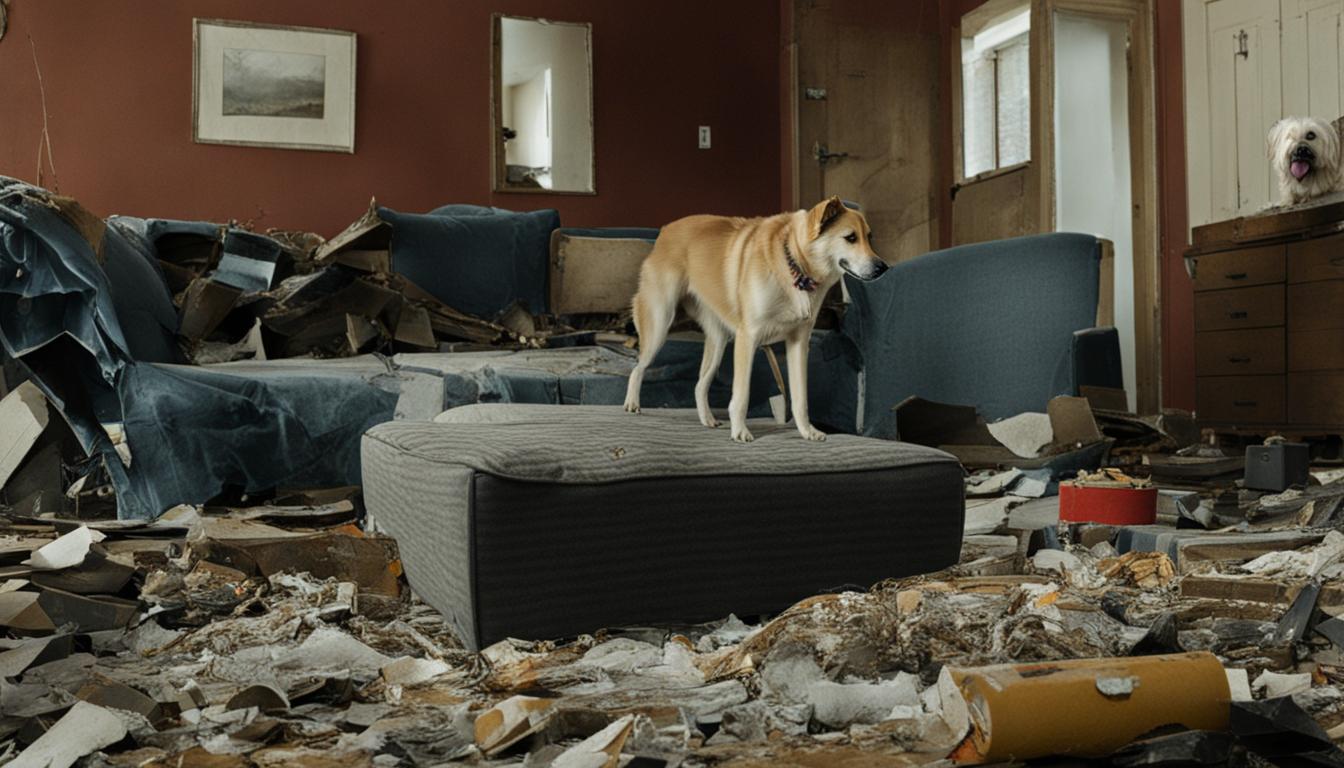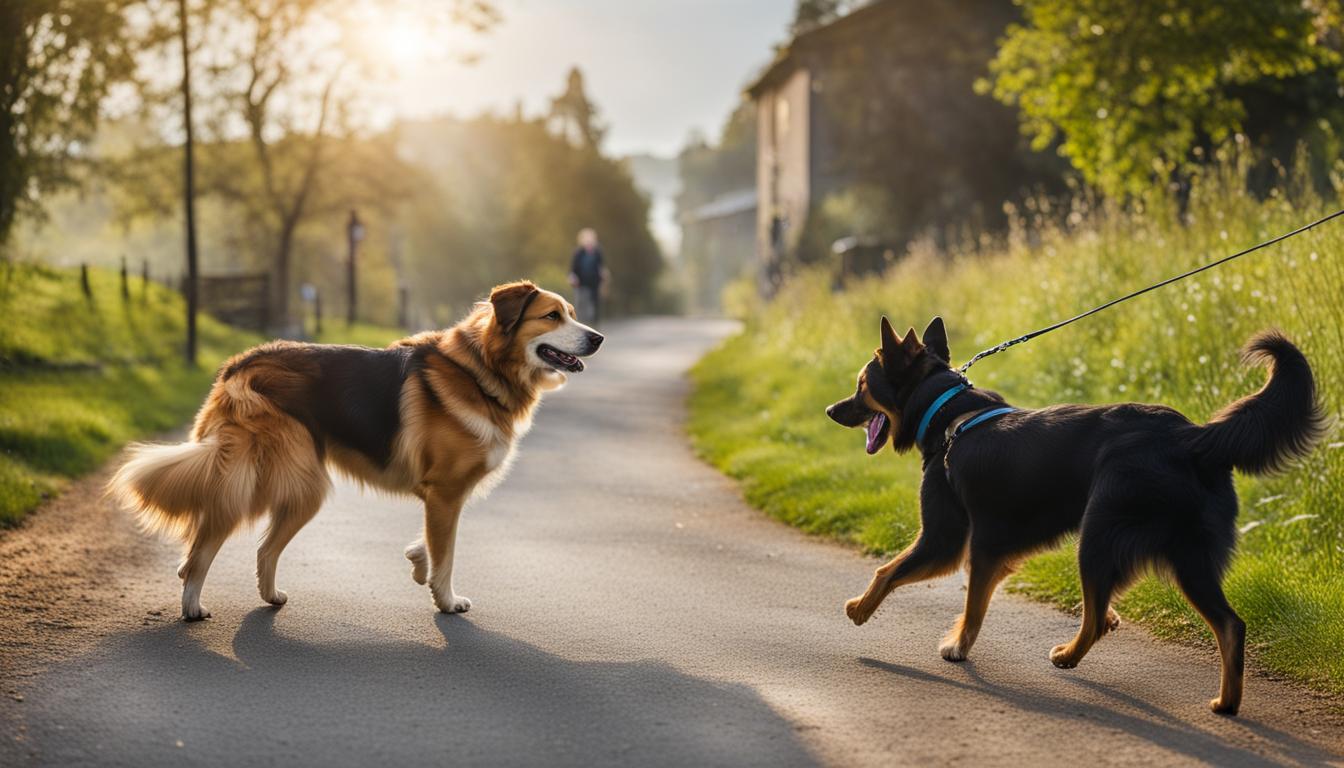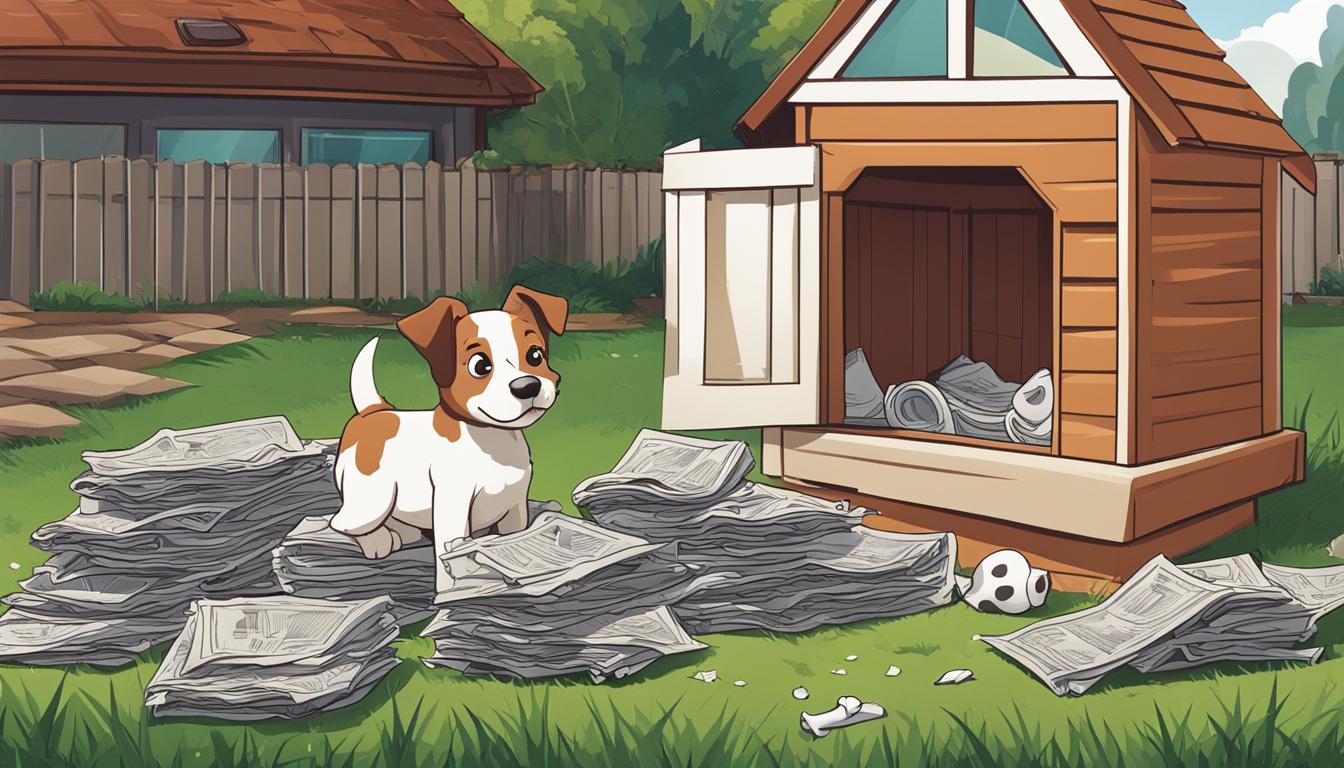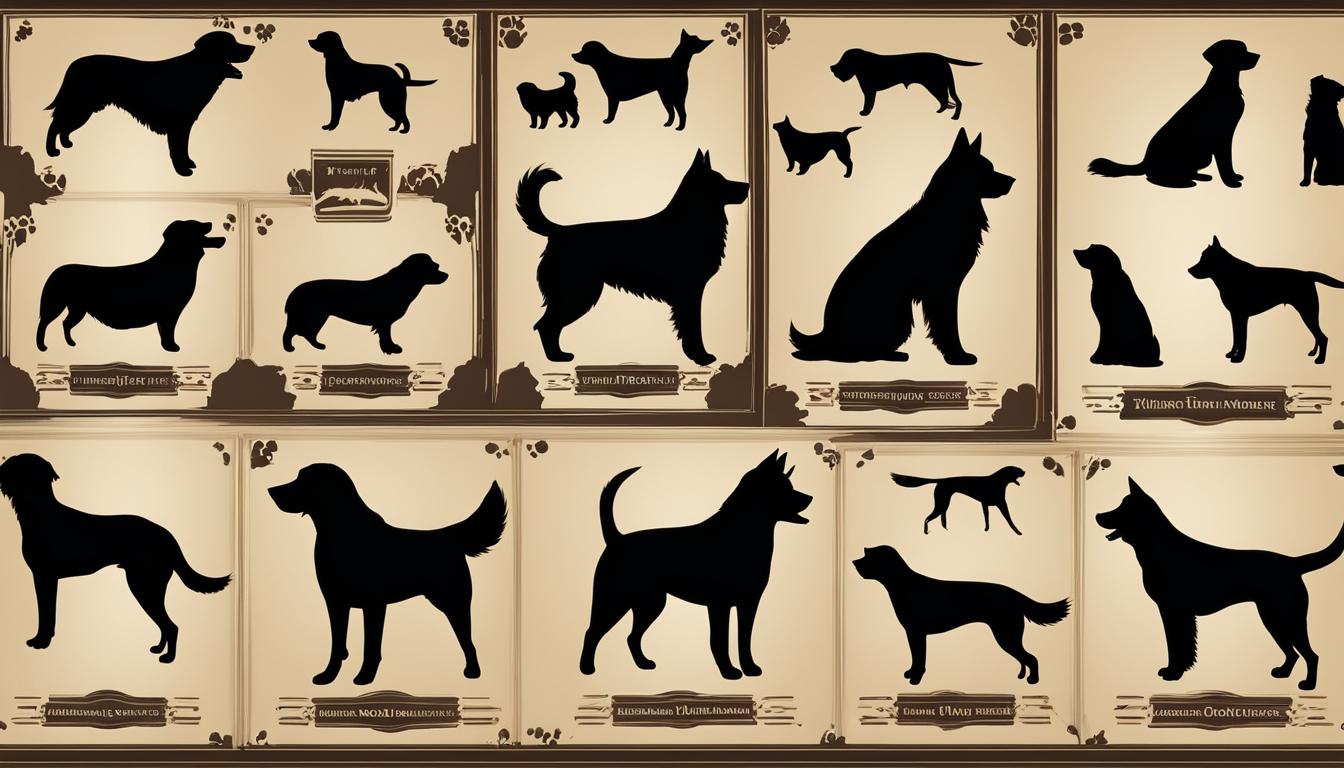Destructive chewing is a common behavior in dogs, especially puppies. It serves various purposes, such as relieving pain from teething, keeping jaws strong and teeth clean, and combating boredom or mild anxiety. However, it can also cause damage to your belongings and create a stressful environment. To address this issue, it’s important to identify the underlying causes of destructive chewing and implement effective strategies to manage or reduce it.
Key Takeaways:
- Preventing destructive chewing in adult dogs requires identifying the underlying causes and implementing appropriate strategies.
- Puppies may chew furniture due to teething, boredom, or anxiety, and providing appropriate chew toys can help redirect their behavior.
- Training against destructive chewing involves teaching dogs what is acceptable to chew on through positive reinforcement and supervision.
- Addressing separation anxiety, fabric sucking behavior, and hunger can help manage destructive chewing in dogs.
- Exercise and mental stimulation are essential in preventing boredom and reducing destructive chewing behavior.
Rule Out Problems That Can Cause Destructive Chewing
When dealing with destructive chewing behavior in dogs, it is important to rule out any underlying problems that may be contributing to this behavior. Separation anxiety is a common issue that can lead dogs to chew intensively when left alone. They may also exhibit other signs of distress, such as pacing or excessive barking. If you suspect separation anxiety, it is crucial to address this issue and provide your dog with the support and reassurance they need.
Another problem that can cause destructive chewing is fabric sucking behavior. This behavior may develop due to early weaning or become compulsive over time. It is important to identify the underlying cause of fabric sucking and address it appropriately. Providing alternative outlets for chewing, such as durable chew toys, can help redirect this behavior.
Hunger or a calorie-restricted diet can also drive dogs to chew on objects related to food. Ensuring that your dog is on a balanced diet and providing them with regular meals can help reduce this behavior. If you suspect hunger may be a contributing factor, consult with your veterinarian to determine the appropriate feeding schedule and portion sizes for your dog.

Table: Common Problems That Can Lead to Destructive Chewing
| Problem | Description |
|---|---|
| Separation Anxiety | Dogs may chew intensively when left alone, along with displaying other signs of distress. |
| Fabric Sucking | Behavior that may result from early weaning or become compulsive over time. |
| Hunger or Calorie-Restricted Diet | Dogs may chew on objects related to food if they are not getting enough to eat or are on a restricted diet. |
By addressing these underlying problems and implementing appropriate strategies, you can effectively manage and reduce destructive chewing behavior in your dog.
How to Manage or Reduce Your Dog’s Destructive Chewing
Puppy teething is a common phase where dogs experience discomfort from teething and have a heightened desire to chew. Providing appropriate teething toys can help alleviate pain and redirect their chewing behavior. It’s also important to recognize that chewing is a natural and normal behavior for dogs. Dogs should have a variety of appropriate chew toys and be taught what is acceptable to chew through gentle guidance and positive reinforcement.
During the teething phase, puppies may experience discomfort and tend to seek relief by chewing on various objects. To prevent them from damaging your belongings, it’s important to provide them with appropriate teething toys. These should be specifically designed for puppies, with textures that soothe their gums and withstand their chewing. Examples include rubber or nylon chew toys that can be frozen to provide additional relief.
It’s crucial to offer a wide variety of chew toys to satisfy your dog’s need to chew. These toys should be durable and safe, without small or easily detachable parts. By providing a range of textures, shapes, and sizes, you can stimulate your dog’s interest and help them develop a preference for appropriate chew items. Additionally, rotating the toys regularly can keep your dog engaged and prevent boredom.
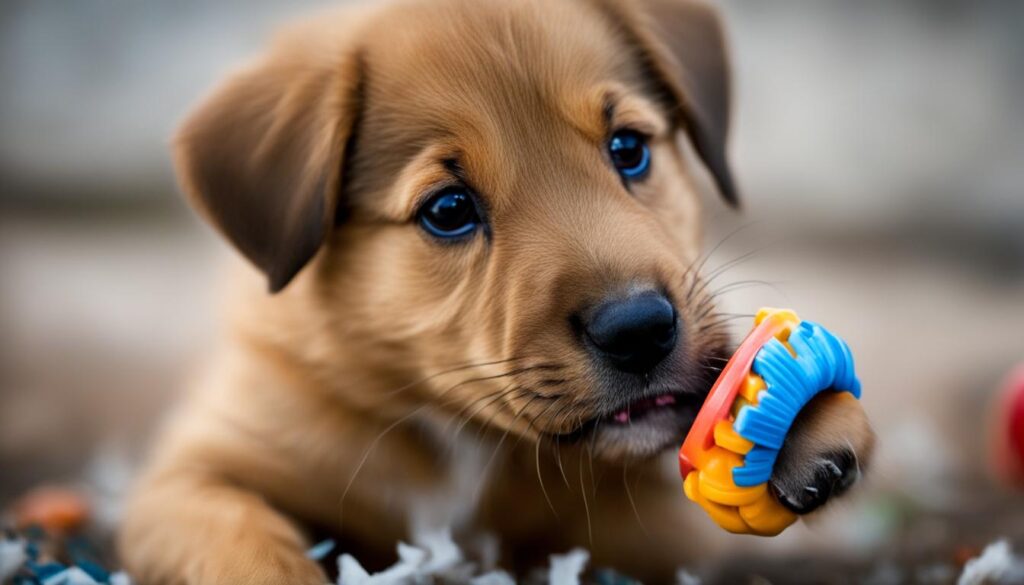
Positive reinforcement is an effective method for teaching your dog what is acceptable to chew. Whenever you see your dog chewing on an appropriate toy, remember to praise and reward them. This positive association will help reinforce their understanding of what is allowed. Conversely, if you catch your dog chewing on something inappropriate, calmly redirect their attention to an approved chew toy and provide positive reinforcement when they engage with it.
Useful Tips for Managing Destructive Chewing
Dealing with destructive chewing can be challenging, but with the right strategies and tools, you can effectively manage this behavior in your dog. Here are some useful tips:
Table: Tips for Managing Destructive Chewing
| Tips | Description |
|---|---|
| “Dog-proof” your house | Remove any valuable objects or items that your dog may be tempted to chew on. Keep them out of your dog’s reach to prevent damage. |
| Provide plenty of chew toys | Offer a variety of safe and durable chew toys for your dog to gnaw on. This will help redirect their chewing behavior to appropriate items. |
| Offer edible chews | Edible chews, such as bully sticks or pig ears, can satisfy your dog’s natural chewing instinct while providing a tasty treat. |
| Identify chewing patterns | Observe your dog’s behavior to identify specific times or triggers that lead to destructive chewing. This will help you address the root causes and find appropriate solutions. |
| Discourage inappropriate chewing | When you catch your dog chewing on something they shouldn’t, firmly say “no” and redirect their attention to a chew toy or appropriate object. Consistency is key to reinforcing this behavior. |
By implementing these tips, you can create a dog-friendly environment that promotes appropriate chewing behavior and reduces the risk of damage to your belongings. Remember, patience and positive reinforcement are essential in training your dog to chew on the right items. Consistency and supervision are key to success.
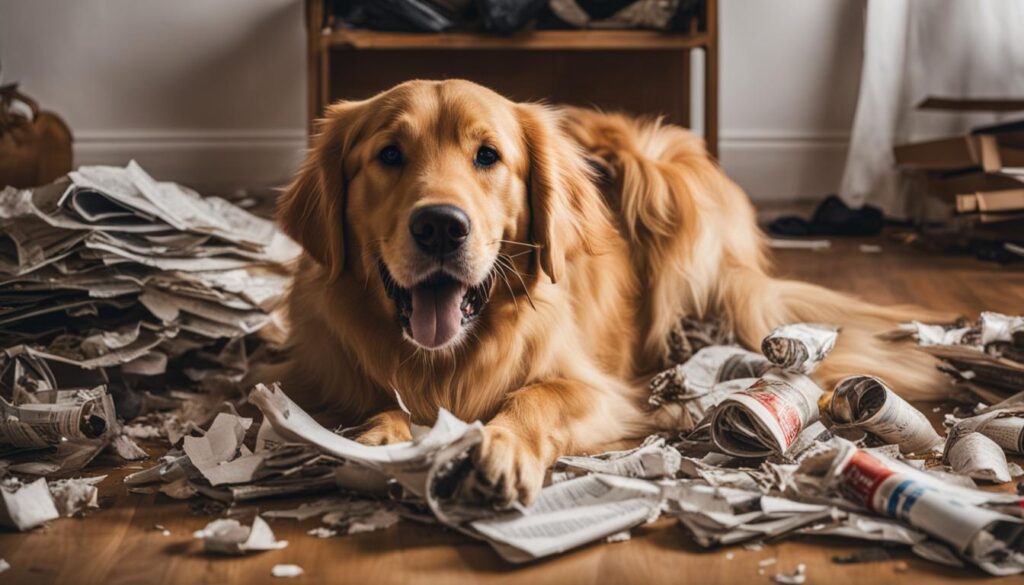
The Importance of Exercise and Mental Stimulation
Destructive chewing in dogs can often be attributed to a lack of exercise or mental stimulation. When dogs are not provided with enough physical and mental activity, they can become bored, frustrated, and seek ways to entertain themselves. Chewing becomes a natural outlet for their pent-up energy and can result in destructive behavior. To prevent this, it is crucial to prioritize exercise and mental stimulation as part of your dog’s daily routine.
The Impact of Lack of Exercise or Mental Stimulation
A dog that does not receive sufficient exercise or mental stimulation is more likely to engage in destructive chewing. This behavior is often a sign of stress and frustration, as the dog seeks an outlet for their excess energy. Without appropriate physical and mental outlets, they may resort to chewing on objects they shouldn’t, such as furniture, shoes, or household items. This not only leads to damage in your home but can also pose a safety risk to your dog if they ingest harmful substances or objects.
Keeping Your Dog Physically and Mentally Stimulated
To prevent destructive chewing due to lack of exercise or mental stimulation, it is important to provide your dog with ample opportunities for both. Regular exercise, such as daily walks or playtime in the backyard, helps to burn off excess energy and keeps your dog physically fit. Additionally, engaging in activities such as agility training, obedience training, or interactive play sessions can provide mental stimulation and challenge your dog’s cognitive abilities.
Incorporating puzzle toys, treat-dispensing toys, or interactive feeding bowls can also help keep your dog mentally stimulated. These toys encourage problem-solving, engage their senses, and provide a rewarding experience. Additionally, rotating and introducing new toys regularly can keep your dog’s interest and prevent boredom.
| Benefits of Exercise and Mental Stimulation for Dogs |
|---|
| Improves overall physical health and fitness |
| Reduces excess energy and restlessness |
| Prevents obesity and weight-related health issues |
| Enhances mental well-being and reduces anxiety |
| Strengthens the bond between you and your dog |
Remember, a tired dog is a well-behaved dog. By ensuring your dog receives enough exercise and mental stimulation, you can significantly reduce the likelihood of destructive chewing and create a happier, more balanced canine companion.
By prioritizing exercise and mental stimulation, you provide your dog with the outlets they need to stay physically and mentally healthy. This not only helps prevent destructive chewing but also promotes overall well-being. Remember to tailor your dog’s exercise routine to their age, breed, and individual needs. If you have any concerns about your dog’s behavior or appropriate activities, consult with a professional trainer or behaviorist to ensure you are providing the best possible care for your furry friend.
Teaching Your Dog What to Chew
Once you’ve identified the underlying causes of destructive chewing in your dog and implemented strategies to manage or reduce it, the next step is to teach your dog what is appropriate to chew on. By redirecting their attention to approved toys and providing appropriate guidance, you can help steer them away from destructive chewing habits.
Supervision is key, especially for puppies or dogs who are prone to chewing. When you can’t directly supervise them, it’s important to confine them in a safe and chew-proof area. By doing so, you can prevent them from engaging in destructive chewing and redirect their attention to acceptable chew toys when necessary.
For teething puppies, frozen toys can be a great option. Simply wet a toy or rope and place it in the freezer for a few hours. The cold temperature can soothe your puppy’s gums and provide relief during the teething process. Remember to always monitor your puppy while they are chewing on frozen toys to ensure they don’t swallow any small pieces.
Tips for Teaching Your Dog What to Chew:
- Provide a variety of appropriate chew toys for your dog
- Guide your dog towards approved toys whenever you catch them chewing on something they shouldn’t
- Use positive reinforcement to reward your dog for chewing on appropriate items
- Teach your dog clear boundaries and consistently reinforce what they are allowed to chew
By consistently redirecting your dog’s attention to approved toys and rewarding them for appropriate chewing behavior, you can effectively teach them what is acceptable to chew on. Remember, it’s important to be patient and consistent throughout the training process, as it may take time for your dog to learn and adjust their chewing habits.
| Teaching Your Dog What to Chew | Tips |
|---|---|
| Supervision | Confine your dog in a chew-proof area when unsupervised |
| Frozen Toys | Provide frozen toys for teething puppies |
| Variety of Chew Toys | Offer a selection of appropriate chew toys for your dog |
| Positive Reinforcement | Reward your dog for chewing on approved items |
| Clear Boundaries | Consistently reinforce what your dog is allowed to chew |
Avoid Punishment and Focus on Positive Reinforcement
Punishment is rarely effective in addressing destructive chewing behavior in dogs. It can create fear and anxiety, leading to defensive reactions or even worsening the problem. Instead, it is crucial to focus on positive reinforcement to encourage appropriate chewing habits. By building trust and fostering a positive relationship with your dog, you can effectively address and correct their behavior.
“Punishment doesn’t work; it only creates fear and mistrust. Positive reinforcement, on the other hand, allows dogs to learn through rewards and encouragement.”
Positive reinforcement involves rewarding your dog for engaging in desired behaviors, such as chewing on approved toys or exhibiting calm behavior. This can be done through praise, treats, or other forms of positive reinforcement. By rewarding your dog for appropriate chewing, you are reinforcing the behavior you want to see more of, while simultaneously discouraging destructive chewing.
In addition to positive reinforcement, building a strong bond with your dog is essential. Spend quality time together, engage in fun activities, and provide opportunities for mental and physical exercise. A strong bond will help your dog feel secure and less prone to destructive behaviors.
Remember, every dog is unique, and it may take time and patience to address destructive chewing. If you are facing challenges or need guidance, consider consulting with a professional dog behaviorist or trainer who can provide expert advice tailored to your dog’s specific needs.
Key Takeaways
- Punishment is not effective for addressing destructive chewing and can lead to fear and defensive reactions in dogs.
- Positive reinforcement, such as rewards and encouragement, is a more effective approach.
- Building a strong bond and trust with your dog is important in addressing and correcting their behavior.
- Consider seeking guidance from a professional if you are facing challenges in managing destructive chewing.
Conclusion
Managing and reducing destructive chewing behavior in dogs is essential for creating a harmonious environment and protecting your belongings. By understanding the underlying causes and implementing appropriate strategies, you can effectively address this common issue. Here are some dog chewing prevention tips to help you:
Prevent access to inappropriate items
One of the key steps in managing destructive chewing is to dog-proof your home. Keep valuable objects out of reach and create a safe environment for your furry friend. This will help minimize the chances of your dog engaging in destructive chewing.
Provide ample chew toys
Offering your dog plenty of appropriate chew toys is crucial. These toys will not only keep your dog engaged and mentally stimulated but also satisfy their natural chewing instinct. Be sure to rotate the toys regularly to prevent boredom and maintain their interest.
Addressing anxiety-driven chewing
If your dog’s destructive chewing is driven by anxiety or other underlying issues, it’s important to seek professional help. Consult with a behaviorist or trainer who can provide guidance and develop a customized plan to address your dog’s specific needs.
Remember, punishment is not the solution when it comes to managing destructive chewing. Instead, focus on positive reinforcement and building a trusting relationship with your dog. By taking proactive steps and implementing these dog chewing prevention tips, you can effectively manage and reduce destructive chewing behavior, creating a happier and more harmonious home for both you and your furry companion.
FAQ
How can I prevent my dog from destructive chewing?
To prevent destructive chewing, you can dog-proof your house by keeping valuable objects out of reach. Providing plenty of chew toys and rotating them regularly can also prevent boredom. Offering edible chews like bully sticks or pig ears can satisfy your dog’s natural chewing instinct.
Why do dogs chew destructively?
Dogs may chew destructively to relieve pain from teething, keep their jaws strong and teeth clean, combat boredom or mild anxiety, or due to specific problems like separation anxiety or fabric sucking behavior. Identifying the underlying cause is important to address the behavior effectively.
How can I manage destructive chewing during teething?
During teething, providing appropriate teething toys can help alleviate your dog’s pain and redirect their chewing behavior. It’s important to recognize that chewing during teething is natural and normal for dogs. Gentle guidance and positive reinforcement can teach them what is acceptable to chew on.
Are there any effective strategies to discourage inappropriate chewing?
Yes, there are several strategies you can use. You can use deterrent sprays to discourage your dog from chewing on inappropriate objects. Supervising your dog’s behavior and redirecting their attention to approved toys can also be effective. Offering puzzle toys during specific times when your dog is prone to chewing can redirect their attention as well.
Can lack of exercise or mental stimulation contribute to destructive chewing?
Yes, boredom and frustration can drive dogs to find ways to entertain themselves, which may include destructive chewing. Providing ample opportunities for physical and mental exercise, playtime, training, and mental stimulation can help reduce destructive chewing behavior.
How should I teach my dog what is appropriate to chew on?
You can teach your dog what is appropriate to chew on by redirecting their attention to approved toys. Supervision is crucial, especially for puppies, to prevent them from engaging in destructive chewing. For teething puppies, frozen toys can help soothe their gums and provide relief. Clear boundaries and consistent reinforcement are key to teaching your dog what they are allowed to chew.
Is punishment an effective method to address destructive chewing?
No, punishment is not an effective method to address destructive chewing. It can lead to fear and defensive reactions in dogs and may even worsen the behavior. Positive reinforcement, such as rewarding your dog for chewing on appropriate items, is a more effective approach. Building a trusting and positive relationship with your dog is essential for addressing and correcting their behavior.
What should I do if my dog’s destructive chewing is driven by anxiety?
If your dog’s destructive chewing is driven by anxiety or other underlying issues, it’s recommended to consult with a professional behaviorist or trainer. They can provide guidance and develop a customized plan to address the root causes of the behavior.

